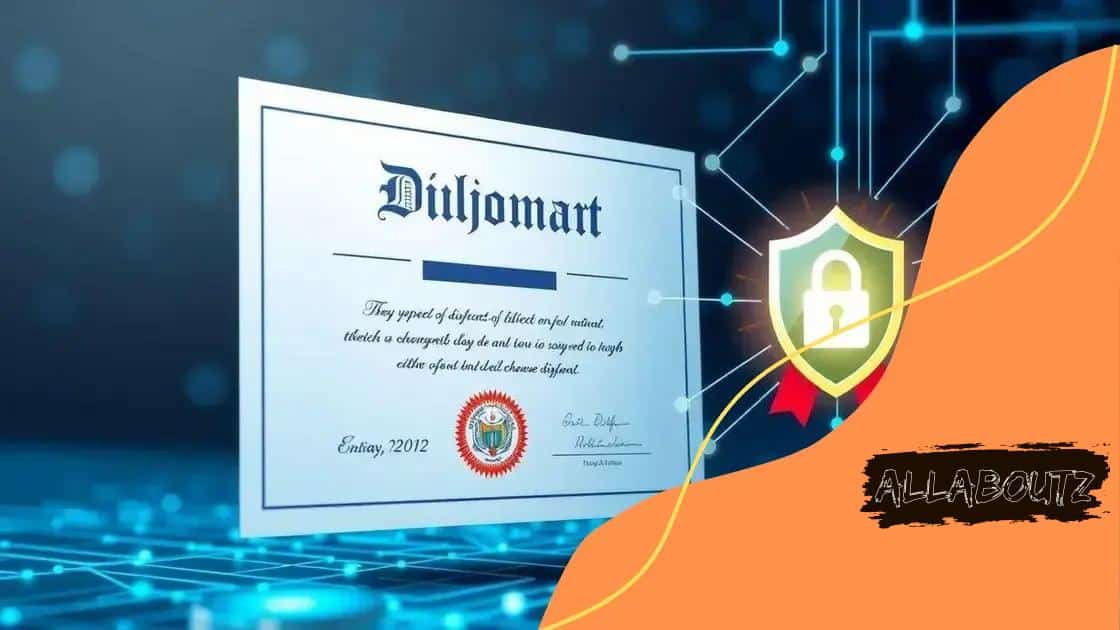Blockchain in academic credential verification: a game changer

Blockchain in academic credential verification enhances security, allows immediate verification of qualifications, and prevents fraud, while also addressing challenges like technical barriers and interoperability among systems.
Blockchain in academic credential verification is set to revolutionize how we validate degrees and certifications. Imagine a future where you can instantly verify educational credentials with absolute certainty. This technology could change everything.
Understanding blockchain technology
Understanding blockchain technology is crucial for grasping its applications in various fields, especially in education. At its core, blockchain is a decentralized ledger system that records transactions across many computers securely. This means that once a record is added, it cannot be altered without the consensus of the network.
Key Features of Blockchain
Blockchain has several key features that make it unique:
- Decentralization: Unlike traditional systems, there is no central authority controlling the data.
- Transparency: All changes are visible to participants in the network, ensuring accountability.
- Security: Transactions are encrypted and linked, making it very difficult to tamper with the data.
Understanding blockchain goes beyond just knowing its definition. It involves recognizing how this technology ensures high levels of data integrity and security. For instance, when an academic institution issues a diploma, it can be entered into a blockchain. This record is then permanently stored and accessible for verification by employers and other institutions.
How Blockchain Works
Each transaction or data entry is grouped into a block. Once a block reaches its capacity, it is added to a chain of previous blocks, thus forming a secure and unchangeable chain of information. This process is known as mining, and it also involves solving complex mathematical problems that validate transactions.
Another aspect to consider is how blockchain technology enhances trust among users. In a traditional system, individuals must trust the central authority to manage their data. With blockchain, trust is built into the system, which reduces the need for intermediaries and lowers the risk of fraud.
Moreover, as we delve deeper into the potential of blockchain, we see its ability to facilitate immediate verification. This can streamline processes in academic settings, where timely validation of credentials is essential. Institutions can link their databases to the blockchain, allowing for real-time access to records.
Advantages of using blockchain for credentials
The advantages of using blockchain for credentials are becoming increasingly clear as educational institutions explore this innovative technology. By leveraging blockchain, schools and universities can enhance the process of issuing and verifying academic qualifications.
Enhanced Security
One major advantage is the heightened security it offers. Blockchain technology uses encryption to protect data, ensuring that academic records are safe from tampering. This is vital in today’s world, where diploma fraud can undermine the credibility of educational institutions.
Immediate Verification
Another key benefit is the ability to achieve immediate verification. Blockchain allows employers and schools to instantly access a candidate’s academic history. This speeds up the hiring process and provides greater confidence in the qualifications presented.
- Fraud prevention: Reduces the incidences of fake degrees and false credentials.
- Cost efficiency: Lowers administrative costs related to credential verification processes.
- Accessibility: Ensures that records are easily accessible by authorized parties.
Moreover, blockchain technology fosters transparency. When academic credentials are stored on a blockchain, everyone involved in the verification process can see the same information. This builds trust between institutions, employers, and students.
Streamlined Processes
In addition to security, blockchain significantly streamlines the credentialing process. Instead of navigating complex bureaucratic systems, a blockchain network allows institutions to issue and verify diplomas in a straightforward manner. This can lead to a smoother experience for students and schools alike.
As educational systems continue to evolve, harnessing the advantages of using blockchain for credentials will play a significant role in shaping more efficient, secure, and reliable methods for managing academic qualifications.
How blockchain enhances verification processes

Blockchain significantly enhances verification processes by providing a secure and transparent way to manage credentials. With traditional systems, verifying academic records can be slow and prone to errors. However, using blockchain technology makes this process faster and more reliable.
Decentralized Verification
The decentralized nature of blockchain means that there is no single point of failure. This reduces the risk of fraud and ensures that records remain intact. When a credential is issued and added to the blockchain, it becomes part of a permanent and unchangeable ledger.
Streamlined Access
Accessing records is also streamlined. Employers can quickly verify a candidate’s educational history without needing to contact the institution directly. This not only saves time but also minimizes the potential for lost or misfiled records.
- Instant verification: Allows immediate access to credentials.
- Reduced administrative burden: Helps reduce time and resources spent on record verification.
- Increased accuracy: Minimizes human error during the verification process.
By implementing blockchain, educational institutions can provide a digital badge or certificate that links directly to the blockchain. This feature empowers graduates to showcase their credentials easily and securely. When employers see this badge, they can confidently verify the authenticity of a degree.
Furthermore, blockchain technology enhances data consistency. Since all records are updated in real-time and visible to all authorized users, discrepancies are less likely to occur. This consistency fosters trust between education providers and employers, making it easier to verify qualifications efficiently and reliably.
Real-world applications in education
Real-world applications of blockchain technology in education are transforming how we manage academic credentials. Universities and colleges are beginning to realize the benefits of using this innovative system.
Digital Diplomas
One of the most exciting applications is the issuance of digital diplomas. By using blockchain, institutions can create a secure and verifiable digital version of diplomas. This ensures that the information is safe from manipulation and easily accessible by potential employers.
Course Verification
Another application is in course verification. Institutions can record course completions and credits on the blockchain. This allows students to carry their education history with them in a secure format. Employers can trust that the credentials are accurate without having to go through lengthy verification processes.
- Improved trust: Employers can easily verify the authenticity of credentials.
- Global accessibility: Digital records can be accessed from anywhere in the world.
- Efficient record-keeping: Reduces paperwork and simplifies administrative processes.
Furthermore, some universities are partnering with blockchain companies to develop platforms that are solely dedicated to educational credentials. These platforms allow students to control who can view their information, adding another layer of privacy.
Decentralized Learning Platforms
Another interesting area is decentralized learning platforms. These initiatives allow students to learn directly from educators without intermediaries. Blockchain can facilitate payments and content sharing, ensuring all parties receive fair compensation.
Additionally, students can earn credentials for completing courses on these platforms, with their achievements recorded on the blockchain. This not only enhances the learning experience but also provides valuable accreditation for skills acquired outside traditional educational settings.
Challenges and considerations in implementation
Implementing blockchain technology in academic credential verification comes with several challenges and considerations. While the benefits are clear, institutions must navigate specific obstacles to harness its full potential.
Technical Barriers
One significant challenge is the need for technical expertise. Many educational institutions may lack the necessary skills or knowledge to integrate blockchain systems effectively. This can lead to delays and errors during implementation. Providing training for staff and investing in the right technology is essential for a successful transition.
Interoperability Issues
Another consideration is interoperability. Different institutions may use various blockchain platforms, which can complicate the process of verifying credentials across systems. For effective communication between these platforms, standardized protocols are needed. Without standardization, the goal of seamless verification may remain unachievable.
- Collaboration: Institutions need to work together to establish common standards.
- Clear regulations: Develop guidelines that govern how blockchain data is stored and shared.
- Data privacy: Protect sensitive information while ensuring accessibility for verification.
Furthermore, legal and regulatory challenges can arise. Laws related to data protection and privacy vary by region. Institutions must ensure that their blockchain solutions comply with these regulations, which can require significant legal oversight. This challenge can slow down the adoption process.
Cost Considerations
The financial investment involved in implementing blockchain can also be daunting. Developing a blockchain system or partnering with third-party providers may require considerable funding. Educational institutions, often operating on tight budgets, must weigh these costs against potential benefits.
Finally, gaining stakeholder buy-in is crucial. Faculty, administrators, and students may need convincing about the advantages of shifting to a blockchain-based system. Effective communication about the benefits and how it improves existing processes can help in garnering support.
FAQ – Frequently Asked Questions about Blockchain in Academic Credential Verification
What are the main advantages of using blockchain for academic credentials?
The main advantages include enhanced security, immediate verification of credentials, and improved trust between institutions and employers.
What challenges do schools face when implementing blockchain technology?
Challenges include technical barriers, interoperability between different systems, legal regulations, and the financial costs of implementation.
How does blockchain ensure the authenticity of academic records?
Blockchain creates a decentralized and tamper-proof ledger that securely records academic credentials, making it easy to verify their authenticity.
Can blockchain be used for online learning platforms?
Yes, blockchain can support decentralized learning platforms by allowing students to earn credentials directly for courses they complete, ensuring secure and transparent record-keeping.





